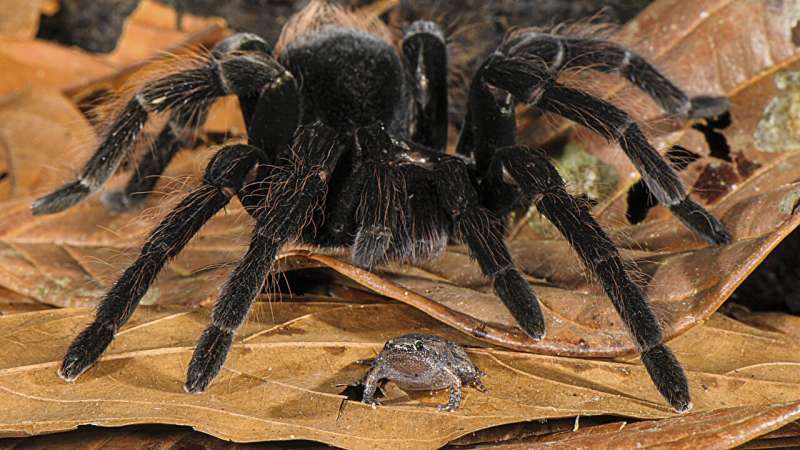
So much science news this week. It’s like a torrential deluge of information bursting explosively through a levee of ignorance. Who built that levee, anyway? How did they get that through the legislature? Anyway, of the hundreds of stories we reported this week, here are capsules of three interesting ones. Two of them involve bugs.
Housemates unlikely
People tend to have one of two reactions to tarantulas: a sharp, primal terror that author David Foster Wallace described as “the howling fantods,” or the kind of attachment more commonly associated with kittens and puppies. People are just not indifferent to tarantulas.
A study from the University of Turku describes newly discovered ecological relationships between the gentle, hairy spiders and amphibians, reptiles and insects. The report includes the actually astounding fact that small frogs often cohabitate with tarantulas, benefiting from the shelter of tarantula burrows and providing a service to their hosts by eating insects that can be harmful to the spider or its eggs.
Additionally, the study proposes that tarantulas became hairy as a defense mechanism against predatory ants. The researchers observed army ants entering a tarantula burrow and cleaning away food remains, leaving the burrow tidier than they found it. A few of the ants that attempted to attack the tarantula were repelled by the fringe of stiff, protective hair on the tarantula’s legs.
“The dense hair covering the tarantula’s body makes it difficult for the ants to bite or sting the spider. Therefore, we believe that the hairiness may have evolved as a defense mechanism. This hypothesis is supported by findings that many burrowing New World tarantulas cover their egg sacs with urticating hairs,” says first author Alireza Zamani from the University of Turku.
Chaos quantified
Black holes can only be observed indirectly, via X-ray emissions from accretion disk flares. Many black holes have companion stars, and over time, draw matter from their companions into equatorially orbiting rings. These accretion disks are highly dynamic and poorly understood, and astronomers have been attempting to model them for decades. Researchers at the University of Helsinki wanted to know specifically how opaque hot zones and transparent cold zones develop within the accretion disk and lead to detectable outbursts.
They developed supercomputer simulations to model the interactions of radiation, plasma and magnetic fields around black holes, including quantum interactions, and determined that the turbulence within the accretion disk is caused by the magnetic fields heating local plasma and causing it to emit X-ray radiation. It represents the first plasma physics model to incorporate quantum interactions between radiation and plasma and answers questions about black hole dynamics that physicists first began asking in the 1970s.
The study describes how electrons and positrons, which are mutually annihilating antiparticles, can occur in the same location in proximity to the extreme conditions around black holes, and explains how the plasma comprising the accretion disk can have both hot and cold regions.
‘Get to da choppah!’
How do mosquitoes target their hosts so accurately? They actually integrate information from multiple sensory sources, including the odor of exhaled CO2, inputs that can vary with distance to their prey. But according to a study by researchers at the University of California, Santa Barbara, one of these senses is infrared vision similar to the HUD overlay used by the alien hunter in the 1987 film “Predator” to target its human prey. The study found that in combination with CO2 detection, infrared radiation from a source with the temperature of human skin would prompt mosquitoes to double their host-seeking behavior.
In a laboratory setting, the researchers exposed female mosquitoes to human odors and CO2. In a separate zone, they were also exposed to infrared radiation from a skin-temperature source. The mosquitoes with IR exposure displayed twice the probing behavior as the mosquitoes from the first zone.
Nicolas DeBeaubien, a postdoctoral researcher at UCSB, said, “What struck me most about this work was just how strong of a cue IR ended up being. Once we got all the parameters just right, the results were undeniably clear.” However, it is still unclear whether rolling in a muddy riverbank to suppress IR is as effective against mosquitoes as alien predators.
© 2024 Science X Network
Citation:
Saturday Citations: Tarantulas and their homies; how mosquitoes find you; black holes not mysterious at all (2024, August 24)
retrieved 24 August 2024
from https://phys.org/news/2024-08-saturday-citations-tarantulas-homies-mosquitoes.html
This document is subject to copyright. Apart from any fair dealing for the purpose of private study or research, no
part may be reproduced without the written permission. The content is provided for information purposes only.
